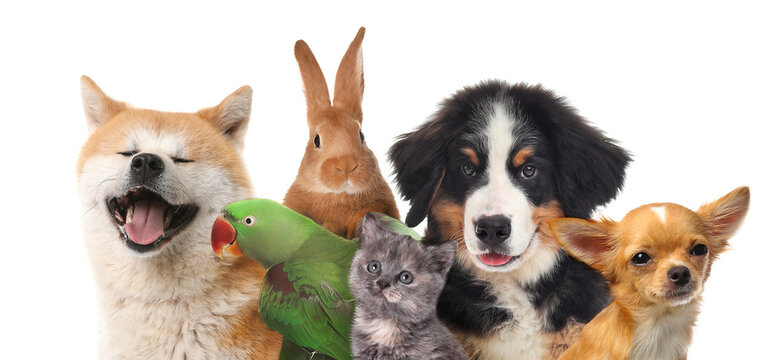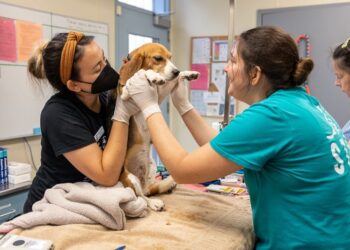Bringing a new dog or cat into your home is an exciting milestone, marking the beginning of a beautiful journey together.
Preparing the Sanctuary—Before the Arrival
![]()
The foundation for a successful transition is laid long before your new pet steps paw across the threshold, focusing on safety, resources, and a dedicated retreat.
A. Home Safety and Proofing
Every responsible owner must first “pet-proof” their environment to ensure the safety of their curious new arrival, removing temptation and potential hazards.
- A. Secure Hazardous Items: Place all cleaning chemicals, medications, and small, swallowable objects like coins or buttons well out of reach.
- B. Remove Toxic Plants: Identify and eliminate any household plants known to be poisonous to cats and dogs, such as lilies (especially toxic to cats), sago palms, or azaleas.
- C. Tidy Electrical Cords: Tucking away or securing exposed wires prevents chewing, which can lead to painful burns or electrocution.
- D. Block Escape Routes: Ensure all windows are screened securely, fences are intact, and small gaps under gates or doors are blocked, especially for energetic dogs or escape-artist cats.
B. Setting Up the Designated Safe Space
A newly adopted pet, especially one from a shelter, is overwhelmed and anxious, needing a small, controlled area that serves as their secure base camp before exploring the vast, scary world of your home.
- A. Choose a Quiet, Private Room: A spare bedroom, a quiet office, or even a large bathroom works perfectly, as long as it’s low-traffic and easily secured with a door or baby gate.
- B. Equip with Essentials: Within this room, place their food and water bowls, a comfortable bed, a few stimulating toys, and, for cats, an easily accessible litter box.
- C. Provide Hiding Spots: Especially crucial for cats, offer covered beds, cardboard boxes, or tunnels, giving them the choice to retreat and observe safely.
- D. Install Pheromone Diffusers: Consider using species-specific synthetic pheromone diffusers (like Adaptil for dogs or Feliway for cats) in this room and nearby areas to chemically signal safety and reduce ambient stress.
C. Acquiring Necessary Resources
Ensuring you have all the essential supplies ready eliminates panic shopping and allows you to focus solely on comforting your pet during the initial phase.
- A. Food and Bowls: Have a supply of the food they were eating at the shelter, gradually transitioning to a new food over several weeks to avoid digestive upset.
- B. Bedding and Carriers: Provide soft, washable bedding and keep the carrier they arrived in available in the room, as it smells familiar and can function as an additional safe den.
- C. Identification: Even if microchipped, ensure your pet has a collar with an up-to-date ID tag listing your phone number, applied immediately upon arrival.
- D. Grooming and Waste: Stock up on brushes, nail clippers, cleaning supplies for accidents, and litter for a new cat.
The First 24 Hours—Settling In
The first day is about minimal stress, allowing your pet to acclimate to your smell, your sound, and the contained safety of their new private room.
A. The Calm Arrival
How you manage the transition from the car to the safe room sets the tone for your pet’s comfort level.
- A. Minimize Chaos: Avoid inviting guests or holding a celebratory party on the first day; the environment should be quiet and predictable.
- B. Transport Safely: Bring the pet home in a secure carrier or on a well-fitted harness and leash, moving directly to their designated room without detouring through the house.
- C. Initial Confinement: Once in the room, open the carrier door and allow the pet to exit and explore on their own terms, resisting the urge to pull them out or force interaction.
- D. Monitor and Retreat: Stay in the room quietly for a few minutes, speaking in soft, reassuring tones, then leave the room to give the pet time to sniff and relax in privacy.
B. Establishing Routine and Trust
Consistency and gentle interaction build the trust necessary for a healthy bond.
- A. Stick to a Schedule: Immediately establish regular, predictable times for feeding, bathroom breaks (for dogs), and short, quiet visits.
- B. Controlled Interactions: For the first few days, your visits to the room should be short, passive, and positive, such as sitting quietly on the floor reading a book while offering a high-value treat.
- C. Gentle Touch: Allow the pet to approach you for affection; if they are hiding, do not force them out, simply respect their need for space.
- D. Supervised Explorations (Dogs): For dogs, brief, leashed walks outside for potty breaks are necessary, but keep these trips short and unhurried to minimize external stress.
Advanced Integration—Introducing to Existing Family

If you have existing pets, the introduction process must be slow, structured, and focused on using scent exchange as the primary tool, respecting the territorial nature of animals, especially cats.
A. The Golden Rule: Scent Before Sight
Scent is a pet’s most important sense, and getting used to a new smell before seeing the animal reduces the shock of a face-to-face meeting.
- A. Keep Separate: Maintain the new pet in their safe room for at least 3-7 days, allowing your resident pets to smell the newcomer under the door and in the hallway.
- B. Swap Bedding: Gently rub a cloth on the new pet’s face and sides, then place that cloth near your resident pet’s food bowl or bedding, and vice-versa.
- C. Trade Places (The “Switcheroo”): Once both parties seem calm about the shared scents, allow the new pet supervised time to explore the main house while the resident pet is confined to the safe room, allowing them to sniff the new environment and territorial marks.
B. Introducing Dogs (The Neutral Ground Approach)
Dog-to-dog introductions should prioritize neutral, open territory to reduce territoriality and give both animals space to use calming body language.
- A. Choose a Neutral Spot: Take both dogs to a safe, quiet public park or a neighbor’s yard where neither has established territory.
- B. Leash and Handler: Ensure both dogs are securely leashed and each has a separate adult handler, ready to interrupt any escalating tension.
- C. Parallel Walk: Start by walking the dogs parallel to one another at a distance where they acknowledge each other but remain calm, gradually reducing the distance over 10-20 minutes, rewarding calmness with treats.
- D. Initial Meeting: If the dogs remain relaxed, allow a brief, loose-leashed sniff-and-greet, immediately diverting them back to parallel walking to avoid intense staring or confrontation.
- E. Supervised Home Entry: Once back home, allow the new dog to enter the house first to sniff around alone, which can sometimes diffuse territoriality before the leashed resident dog is brought inside.
C. Introducing Cats and Dogs (Safety and Escape)
The primary goal when mixing species is ensuring the cat always has a non-confrontational escape route to vertical space or a safe room.
- A. Practice Obedience: Before the meeting, ensure the dog has reliable “Sit,” “Stay,” and “Leave It” commands, using a high-value treat to reinforce calm behavior.
- B. Controlled Introduction: Put the dog on a leash and bring them into the cat’s safe room, letting the dog focus on a Kong or puzzle toy for distraction.
- C. Cat’s Choice: Allow the cat to determine the level of interaction, ensuring they have immediate access to a high perch or hiding spot.
- D. Reward Calmness: Heavily reward the dog for ignoring the cat and the cat for curiosity rather than fear, immediately separating them if either animal shows signs of aggression or high stress.
Post-Adoption Pitfalls and Solutions
The period after the “honeymoon phase” often brings behavioral challenges as the pet drops their guard and truly settles in.
A. Addressing House-Training Setbacks
Accidents are common in the first few weeks due to stress, a new environment, or a lack of clarity on house rules.
- A. Increased Trips: Take the dog outside more frequently than necessary, especially after waking, eating, and playing, to maximize successful eliminations.
- B. Praise and Reward: Celebrate every successful outdoor elimination with enthusiastic praise and a high-value treat, making it a highly rewarding event.
- C. Clean Thoroughly: Clean indoor accidents immediately and thoroughly with an enzymatic cleaner designed to eliminate all odor traces, preventing the pet from returning to the same spot.
B. Managing Resource Guarding
Some adopted pets, particularly those who experienced scarcity, may guard food bowls, toys, or resting spots against other pets or even people.
- A. Feed Separately: During the transition, feed all pets in their separate crates or rooms, removing their bowls immediately after they finish eating.
- B. Manage High-Value Items: Remove high-value toys, chews, and bones that might trigger conflict until a positive relationship between the pets is firmly established.
- C. Professional Help: If resource guarding is directed aggressively toward people, seek immediate guidance from a certified veterinary behaviorist to address the root fear.
C. Seeking External Support
Remember that you don’t have to navigate challenging transitions alone.
- A. Veterinary Check-up: Schedule a full check-up within the first week to establish care, check vaccination status, and rule out any underlying health issues that may contribute to anxiety.
- B. Training Classes: Enrollment in positive reinforcement training or socialization classes is invaluable for building confidence and strengthening the human-animal bond.
- C. Behavioral Consultation: If you observe persistent signs of anxiety, destructive behavior, or aggression that do not improve with routine changes, consult a specialist.
Conclusion
The act of welcoming a newly adopted pet is a profound exercise in patience, empathy, and strategic preparation, a crucial commitment that extends far beyond the emotional moment of signing the papers.
The key to a seamless transition lies in recognizing that your home, which feels safe and familiar to you, is a vast, intimidating, and scent-laden foreign world to a recently displaced animal.
By diligently implementing a protocol centered on the Designated Safe Space, you provide a small, predictable haven that allows your new friend to decompress and begin the critical process of observation and acclimatization on their own terms.
The initial days are not about immediate integration, but about controlled decompression and establishing the cornerstone of trust through quiet, routine, and respect for their need for privacy.
Furthermore, introducing a new companion into a household with existing pets demands the methodical, non-confrontational approach of scent desensitization before any visual contact.
Utilizing strategies like trading bedding, parallel walking on neutral territory for dogs, and always ensuring the cat retains escape access to vertical space prevents panic and the formation of negative, often irreversible, first impressions.
Addressing common post-adoption challenges like house-training setbacks with patience and positive reinforcement, or managing resource guarding by removing high-value conflict triggers, requires consistency and a non-punitive mindset.
Ultimately, success is not measured by how quickly the pets become best friends, but by the gradual, steady decline of their anxiety and the quiet emergence of their authentic, comfortable personalities.
By combining thorough preparation with unwavering patience, you transform a potentially traumatic event into a positive, stable start, cementing the foundation for a loving, lifelong bond with your newest family member.







